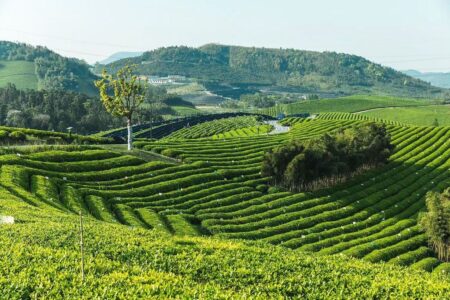Nepali orthodox tea is on the rise

With a focus on producing higher quality orthodox tea, increasing production of organic and certified tea, and utilizing more sustainable practices, Nepal wants to up its game in the premium export market. By Yumi Nakatsugawa
A landlocked country, Nepal, famous for the world’s highest mountains, the Himalayas, is now notably increasing tea production as producers are manufacturing in their own tea factories. The suitable area for growing tea bush is in the eastern part of the country. In fact, some tea estates date back to the 1860s, as old as those of Darjeeling in the hills, and Terai in the plains in the neighbouring West Bengal State of India. Unlike Darjeeling tea, which has established fame in the world, Nepali orthodox tea is in the course of finding a premium export market.
According to the statistics of the National Tea and Coffee Development Board of the Government of Nepal, the country produced 5,085 metric tonnes of tea in fiscal year 1999-2000. The amount increased nearly five-fold to 24,409 metric tonnes in 2016-17. CTC dominates with 18,547 metric tonnes or 76 percent, all produced in Jhapa district in the plains. The remaining 5,862 metric tonnes or 24 percent is orthodox tea, of which 4,885 metric tonnes or 83.3 percent is from Ilam district, followed by Panchathar (8.6 percent), Dhankuta (3.1 percent) and Terathum (88.5 metric tonnes or 1.5 percent).
Five districts were declared as “Tea Zones of Nepal” by the Government of Nepal in 1982 in order to allocate further aid for the development of the tea industry. In fiscal 2016-17, 15,103 small farmers were involved in growing tea in approximately 12,956 hectares (ha) or 46 percent of the national tea cultivation, from which 41 percent of the country’s production is processed. The estate sector accounts for 14,460 metric tonnes or 59 percent from 15,285 ha of land or 54 percent of the total.
Since there is no tea auction centre in Nepal yet, approximately 90 percent of the country’s tea is sold to or through India based on the free trade agreement between the two countries. In addition, the establishment of systematic storage and logistics seem to be a serious requirement in years to come, along with the further advancement of the industry.
Ilam District
The Ilam district is situated in the easternmost part of Nepal and borders the Darjeeling hills. Through the 1990s, most of the small tea growers in Ilam sold their green leaf to the tea factories in Darjeeling. However, since the Darjeeling logo and the Certification Trade Mark (CTM) schemes were introduced in
2000, the use of the word “Darjeeling” along with the logo is strictly limited to the tea that is grown and manufactured in the hilly region of the Darjeeling district. Furthermore, many tea gardens in Darjeeling started to convert to organic farming in the 1990s due to the increasing awareness for food safety in the international market, which made it difficult for Darjeeling producers to buy green leaf from Nepal.
Currently, in the Nepali tea industry, especially in Ilam, most new factories buy green leaf from small farmers. Some selected cultivars from Darjeeling, which mainly originated in Tukdha and Goomtee Tea Estates, are grown in the tea field. Along with 21 decent-sized tea factories in Ilam, which have a manufacturing capacity of several hundred metric tonnes a year, cottage-industry type micro tea factories with Chinese machinery are increasing. Out of 7,965 hectares under tea in the district, 5,120 ha is cultivated by 6,995 small growers who manufactured 2,715 metric tonnes of tea in fiscal year 2016-17. The remaining 2,845 ha under tea belongs to the estate sector, where 2,170 metric tonnes of tea was processed.
Sharing Similarities with Darjeeling
Nepali high grown orthodox teas basically have similar characters to those of Darjeeling teas. Although the current national boundary separates Ilam and Darjeeling districts, for a period between the 18th and 19th centuries, Darjeeling was part of Nepal under the Gorkha dynasty. Nepal and Darjeeling share similar geographical and meteorological conditions. However, the most distinguished flavour of Darjeeling tea praised as “muscatel” in the second flush season is mainly derived from the original Chinese tea bush, which is over 100 years old – Nepali orthodox tea cannot compete as the majority is manufactured from the limited varieties of young clonal bush.
Furthermore, political divisions have resulted in a difference in the stages of development of the tea industry. For example, mechanical plucking by shears or harvesting machines is more widely practised in Ilam than in Darjeeling. On the other hand, ponies still play an important role to carry green leaf to factories on the Nepali side. A critical aspect that should be pointed out is the lower levels of recognition or knowledge about food safety and adequate usage of agrochemicals among the Nepali small tea growers.
There are four certified organic tea estates/factories in Nepal. Three are in Ilam: Himalayan Shangri-La Tea Producers Pvt Ltd, Kanchanjanga Tea Estate Pvt Ltd, and Gorkha Tea Estate Pvt Ltd. The other one is in Dhankuta, called Jun Chiyabari Pvt Ltd.
Gorkha Tea Estate is located in the area called Sundarpani, which means beautiful (sundar) water (pani). It has 40 ha of tea field where planting was started in 1998. The tea factory, at an altitude of 1700 meters, began operations in 2009. Green leaf is bought from three contracted cooperatives of 250 farmers (150 ha of the area is under tea), and about 70 metric tonnes is manufactured per year. Fifteen percent is from estate leaf harvested from three main cultivars, T78, P313 and TV1, brought from Darjeeling.
About 90 percent of the product is black tea known as “light and bright” cup quality, and the rest are green and white teas. While establishing organic farming from 2009-11, the estate distributed 50 cows, 80 cowsheds, 125 biogas facilities as well as compost training to the farmers.
The chairman, Udaya Chapagain, has a broad perspective and has been contributing to the local communities by developing home stay accommodation at farmers’ houses around the factory under the vision of “Tea and Tourism.” He also set up a soccer field for the residents and constructed a helipad that is for future needs. The estate has developed a firm export channel mainly for Germany. Chapagain hopes to expand the business further in the future by entering into new export markets.
Accord India International Pvt Ltd, a tea trader based in Kolkata, India, is deeply involved in production and marketing of Nepali high grown teas. Out of 21 medium and large sized tea factories in Ilam, Accord manages and supervises nine bought leaf factories. As a result, it is the biggest orthodox tea producer in Nepal. Sumaysh Agrrawal, the CEO, is the third generation of the family-owned group companies and mainly looks after marketing. Punam Rai, who was trained in tea estates in Darjeeling, directly supervises tea factories.
To outlines some of its factories: Nepal Small Tea Producers Ltd, the first bought leaf tea factory in Ilam, was established by local farmers in 1993. It was present at the very beginning of tea cultivation by individual growers in the area, who then decided to work collectively in manufacturing their green leaf. A nearby tea factory, Ilam Chiyabari (established in 2010), has been leased to Nepal Small Tea since 2018 as an extension unit for processing as well as storage. At present, tea leaves of TV83, T78, and Goomtee cultivars planted in approximately 500 hectares are brought to these two factories and 600 metric tonnes of tea is manufactured a year. They are marketed under two selling names: Himalayan Bliss and Fikkal Ilam.
Tara Gaun Tea Estate Pvt Ltd (selling brand: Tarachiyabari) is in the Suryodaya Municipality in Ilam, at an altitude of 1640 meters above sea level. “Tara” means star, and “Gaun” means village in Nepali language, so the view from this “star village” factory is magnificent. The snow-capped summit of the world’s third highest mountain, Kanchenjunga, can be seen beyond the tea fields, along with rolling mountains and hill towns of India such as Darjeeling, Kurseong, etc. Tea cultivation in this area started in 1994 and expanded rapidly. The factory, founded in 2013, buys green leaf from 226 hectares under tea in total and manufactures 275 metric tonnes of made tea annually.
Sakhejung Hill Range Tea Processing Industries Pvt Ltd (selling brand: Sakhira) is in a remote and isolated place in Sakhejung village. From the main motorway, four kilometers of unpaved rough road lead to the factory, which was built in 1998. Although Sakhira tea is not organically certified, the green leaf grown in the area is pesticide free and known for its high quality. Sakhira produces about 125 metric tonnes of tea a year.
Construction of Arubote Tea Estate Pvt Ltd’s factory (selling brand: Arubote) began in December 2017, and orthodox tea processing started in June 2018. The Rai tribe dominates the area, and they grow tea along with cardamom and other vegetables. Many local farmers also produce small quantities of green tea in their homes, using very basic methods for their own consumption. The factory expects to produce 125 metric tonnes of tea per year.
Other factories under Accord India International’s supervision are:
- Siddhibinayak Tea Industries Pvt Ltd (selling brand: Kerabari, established in 2012)
- Sunmai Tea Industries Pvt Ltd (Sunmai, 2012)
- Shree Antu Tea Industries Pvt Ltd (Shree Antu, 1998)
- Gramin Chiya Udyog (Himalayan Bliss, 2012).
The group is working extensively on food safety issues and a sizeable volume of its tea meets European Union and Japanese standards. It is aiming to convert all of its produce to Rainforest Alliance certified and is also following Good Manufacturing Practices as well as ISO 22000 protocols.
Apart from those relatively large tea factories, several mini factories have increased significantly in recent years. Some of them do not look like typical tea factories from the outside, seeming more like storage houses or garages, but are equipped with smaller-sized Chinese machinery such as withering trough, rotor flying pan, tea roller and dryer, and produce black tea, pan-fried green tea and some specialty teas. The accurate number of those micro factories is unknown, and many of them have found it difficult to continue manufacturing tea due to lack of knowledge or experience in the tea industry. Sagarmatha Chiya Prasodhan Udhyog (Sagarmatha Tea Producer Industries) and Jhulkegham Laghu Chiya Udhyog are in operation, producing 40 to 50 tonnes and 15 to 20 tonnes of tea per year respectively.
Encouraging Sustainable Practices
Since tea has become an important cash crop in the Ilam district, especially in Suryodaya Municipality, the mayor of Suryodaya, Ran Bahadur Rai, encourages local farmers by educating them in eco-friendly, safe and sustainable agricultural practice. In order to improve the standard of harvested leaf, they have made a code of conduct for plucking. Furthermore, Rai aims to convert tea in Ilam to fully organic, and instructs farmers on how to grow particular grasses, feed cows and campaigns for making organic fertilizer at every corner of the municipality.
At the same time, the area keeps a careful watch on the three borders in the east of Nepal to prevent the inflow of harmful chemicals such as DDT, dieldrin, aldrin, endrin and so on. Rai made a poster mentioning 15 banned chemicals in Nepali language to guide tea growers in Ilam in what they should and shouldn’t do for the future success of the tea industry.
Yumi Nakatsugawa has been working as a freelance writer specializing in food and restaurant management. While freelancing, she developed a love of black tea as well as tea-producing countries and tea people. Her passion for black tea has brought her to Sri Lanka, India, Kenya, Indonesia, Nepal, Malaysia, and Papua New Guinea to see tea production firsthand. Based in Japan, Yumi may be reached at: [email protected].



